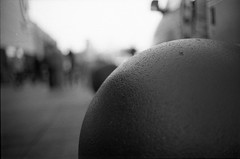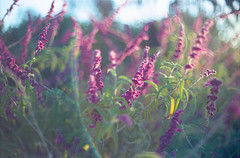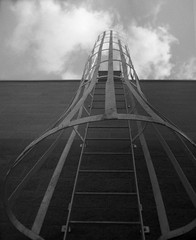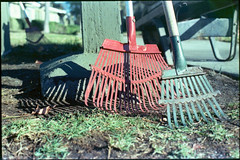Sometimes I go out with a subject in mind (I want to shoot something specific like a building or a puddle or a person). Sometimes I go out with a photograph in mind (I want to shoot something like Porch Shadows by Strand). Ansel Adams always visualized the print he was going to make when he took his camera somewhere. I don't really print, so I usually have a more general idea of what I want to shoot. Not that scanning is so different than printing, but I don't have my end product in mind the way I think AA did. I have gotten into the habit of taking a camera with me almost everywhere. I have decided that it is better to have it and not need it than to need it and not have it. This after many, many times saying to myself "That would make an interesting or beautiful photo... if only I had a camera." I don't count the thing in my phone as a camera, though when I would rather kill myself than miss the shot, I will use it. I have acquired a Yashica Electro 35 GSN that is small and light enough to not be a bother to carry everywhere, but I will still carry a medium format folder or even a TLR if I want to shoot those formats. If I am just carrying a camera around, I will be aware of the film (b/w, color, contrast properties, etc.) and usually pre-set the shutter speed and aperture to something reasonable for the brightest thing I might shoot (Sunny 16 is surprisingly accurate). Then I just wait and see if the light casts an interesting shadow or if there is some odd reflection in a window or even if a building I have passed a thousand times is actually interesting in some way or at some angle. I find myself kneeling, squatting, sitting, laying a lot and the low angle works for my aesthetic sensibility.
 This was taken outside the Target store in my neighborhood. I drive/walk past these concrete spheres all the time, but this day for whatever reason, I thought I would take a photo of one of them. Looking at the scene, there was nothing special, but once I sat down, got the viewfinder up to my eye and started composing I was able to see the shot. I took one frame and moved on. I got a few odd looks, but I am pretty impervious at this point. When I am framing/composing, I look for (obviously) my subject. If I am shooting a rectangular format like 35mm, I almost always use the Rule of Thirds to position the subject. Square formats will tolerate centered subjects better.
This was taken outside the Target store in my neighborhood. I drive/walk past these concrete spheres all the time, but this day for whatever reason, I thought I would take a photo of one of them. Looking at the scene, there was nothing special, but once I sat down, got the viewfinder up to my eye and started composing I was able to see the shot. I took one frame and moved on. I got a few odd looks, but I am pretty impervious at this point. When I am framing/composing, I look for (obviously) my subject. If I am shooting a rectangular format like 35mm, I almost always use the Rule of Thirds to position the subject. Square formats will tolerate centered subjects better. I like blurry backgrounds, so I open the aperture as much as the lighting conditions will allow. I try to find a contrasty angle so if the sun is out I put it to my right or left.
I like blurry backgrounds, so I open the aperture as much as the lighting conditions will allow. I try to find a contrasty angle so if the sun is out I put it to my right or left. I look for lines converging or intersecting
I look for lines converging or intersecting  and consider how that will direct or distract the viewer. Repetition is a great compositional tool that I like to use.
and consider how that will direct or distract the viewer. Repetition is a great compositional tool that I like to use.  It reinforces the subject (look in the background)
It reinforces the subject (look in the background)  . I have to say, that I am of a different mind-set now than when I was shooting digital. As often as not, I look, compose and walk away. I don't feel obligated to actuate the shutter just because I took the time to point my camera at something. Rolls of film sit in my cameras for sometimes weeks. That is why I try to also carry a little Moleskine and jot down notes about the photos I take (date, subject, camera, film, exposure if I know it). That way I can add some data to the photos I share online. My best advice is to start looking at your everyday surroundings through your camera. Get close, get far, get low, get high, turn off the lights and let some faint or diffuse window light fall on things. Don't be afraid to hand hold on long exposures. Blur isn't the end of the world. Just ask Heinrich Kuehn. :)
. I have to say, that I am of a different mind-set now than when I was shooting digital. As often as not, I look, compose and walk away. I don't feel obligated to actuate the shutter just because I took the time to point my camera at something. Rolls of film sit in my cameras for sometimes weeks. That is why I try to also carry a little Moleskine and jot down notes about the photos I take (date, subject, camera, film, exposure if I know it). That way I can add some data to the photos I share online. My best advice is to start looking at your everyday surroundings through your camera. Get close, get far, get low, get high, turn off the lights and let some faint or diffuse window light fall on things. Don't be afraid to hand hold on long exposures. Blur isn't the end of the world. Just ask Heinrich Kuehn. :)Well, I hope there was something of value in there somewhere. I think I have 'developed' an intuition for what I think will look good, but it didn't/doesn't just come naturally. I can definitely tell when I am rushing and when I am thinking. I don't 'feel' the photo as much as I have a process that works when I apply it. I think that is how a lot of artists work. I am still refining the process and trying to slow down and think more frequently and my percentages of 'good' photos is creeping up slowly. If you are one of the lucky few who has 'an eye', then good for you. If not, you might want to start thinking about the 'process of seeing'. Dorothea Lange said, "The camera is an instrument that teaches people how to see without a camera."
No comments:
Post a Comment